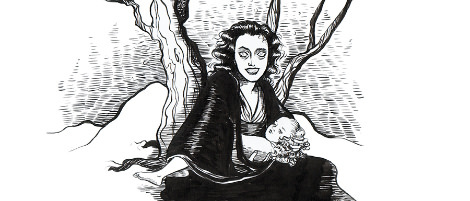
The Encyclopedia of Fantastic Victoriana
by Jess Nevins

"The Old Nurse's Story" (1852)
copyright © Jess Nevins 2022
“The Old Nurse’s Story” was written by Elizabeth Gaskell and first appeared in Household Words (Christmas Number, 1852). Gaskell (1810-1865) was in her time a noted writer. She produced a wide range of stories and novels and was well-known for her “social problem” novels. “The Old Nurse’s Story” is one of the better mid-century ghost stories.
Hester is a nurse hired to take care of Miss Rosamond, the young great-granddaughter of Lord Furnivall. When Miss Rosamond’s parents die Hester and Miss Rosamond are sent to Furnivall Manor House, the home of Miss Rosamond’s grandmother, Miss Furnivall. Furnivall Manor House is a sprawling mansion, inhabited only by Miss Furnivall, her maid and friend Mrs. Stark, and a few other servants. At first Miss Rosamond and Hester are uncomfortable in the Manor House, but soon enough they come to enjoy it. But in October the winter begins with a series of heavy frosts, and Hester hears the mansion’s organ played late at night, as if from far away, despite the organ’s innards being ruined. And then Miss Rosamond sees a child standing out in the snow and gesturing to her. Miss Rosamond follows the ghost, Hester sees the ghost, tragic family secrets are eventually revealed, and Miss Furnivall learns, to her sorrow, that “what is done in youth can never be undone in age!”1
Some aficionados of nineteenth century ghost stories consider “The Old Nurse’s Story” dated and a period piece inferior to later stories. Most readers, however, may feel differently. Gaskell is as good a writer of ghost stories as Mrs. Molesworth (see: “The Story of the Rippling Train”), Amelia B. Edwards (see: “How The Third Floor Knew the Potteries”), and other writers who are better regarded by connoisseurs. The tone of “The Old Nurse’s Story” is wonderful; Gaskell does the Lakeland District tone of Hester’s voice well without indulging in slang or jargon. The characterization in the story is not particularly good, but it does not need to be in a story of this sort. More important elements in this sort of ghost story are atmosphere and pacing, and both are strongly done in “The Old Nurse’s Story.” What sets “The Old Nurse’s Story” apart from many of its contemporaries is the greater complexity of the plot. The reader might have a general idea where Gaskell is going but will not be able predict the story’s ending. Predictability is a failing for many of the mid-Victorian horror writers (see: “The Four-Fifteen Express,” “No. 1 Branch Line: The Signal-Man”) and the lack of same in Gaskell is welcome and combines well with the strong atmosphere of the story.
Recommended Edition
Print: Tara Moore, ed., The Valancourt Book of Victorian Christmas Ghost Stories. Richmond, VA: Valancourt Books, 2016.
Online: http://www.gutenberg.org/ebooks/24879
1 Elizabeth Gaskell, “The Old Nurse’s Story,” in Curious, if True: Strange Tales, accessed Dec. 12, 2018, http://www.gutenberg.org/files/24879/24879.txt.